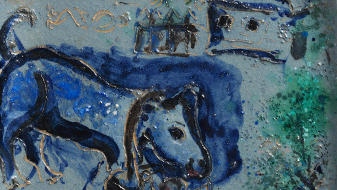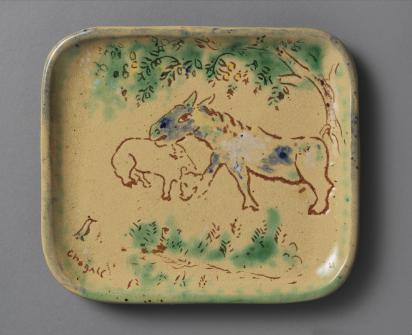After the Second World War, Chagall moved to the South of France and experimented with new media. He turned to ceramics, working with craftsmen, and in 1950, probably in collaboration with Poterie des Remparts in Antibes,1 produced a series of 12 dishes based on La Fontaine's Fables. Gaston Bachelard wrote about the artist in an article for the magazine Derrière le miroir published to coincide with the 1952 exhibition “Marc Chagall: Céramiques, sculptures et Les Fables de La Fontaine (Ceramics, Sculptures and La Fontaine’s Fables) at the Galerie Maeght: “Once again, we have proof that he was destined to write fables, to inscribe them in matter and to sculpt fabulous beings in stone.”2
In 1926, publisher and art dealer Ambroise Vollard commissioned Chagall to make “illustrations for a new edition” of the Fables. The artist created a hundred “dazzling” gouaches in shimmering colors, such as The Wolf and the Lamb (ca. 1927), in preparation for etchings. He and Vollard then faced fierce xenophobic and anti-Semitic attacks, to which the publisher responded in the January 8, 19295 issue of the newspaper L'Intransigeant and years later in a text published posthumously in the same issue of Derrière le miroir: “J’édite les Fables de La Fontaine et je choisis Marc Chagall comme illustrateur” (“I am publishing La Fontaine's Fables and choosing Marc Chagall as illustrator”).6
After the war, Tériade resumed the publishing project interrupted by Vollard's death.7 Then Chagall, who put down roots in the South of France, particularly by making ceramics, returned to the subject. Instead of seeking to achieve visual similarity with the 1920s gouaches, he explored clay’s intrinsic qualities by incising the material, a gesture echoing the etchings, such as on the La Fontaine’s Fables: Two Pigeons [Fables de La Fontaine : Les Deux Pigeons] (1950) dish, which he covered with a bright enamel. He simplified the shapes and colors, dominated by white, ochre, red and blue, and drew from his own bestiary to form a “community of the living”8, in Bachelard’s words. The rectangular shape, recalling the copper plates used for prints, matched that of the ceramic cookware made locally, notably in the nearby town of Vallauris, and displayed an obvious simplicity that coincided with Chagall's early days as a ceramist at the Remparts studio.
The pieces’ lustrous, decorative appearance and the theme of fables recall Italian Renaissance faience. Italian majolica ceramists9 took inspiration from prints to make ornamental dishes10 like enameled paintings. Aesop's fables, translated in Europe in the late 15th century, were the subject of pieces made in Deruta and Gubbio, such as the dish The Falcon and the Capon (1500) now in the Ashmolean Museum, Oxford.1112
In creating this series of “ceramic paintings”, Chagall repeated his tribute to La Fontaine’s Fables, already depicted in prints and gouaches, fostering a dialogue between media.14 He gave the literary monument a new interpretation by shaping the stories in clay and anchoring them in everyday life.
Ceramic
La Fontaine's Fables
The Wolf and the Lamb
(Fables de La Fontaine : Le Loup et l'Agneau)
Keyword:

